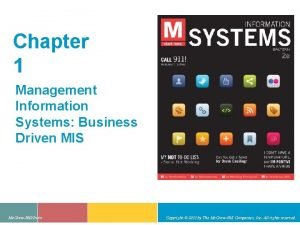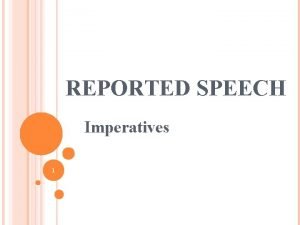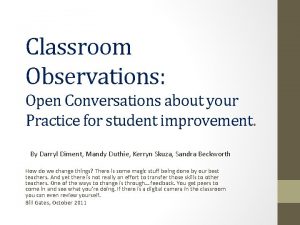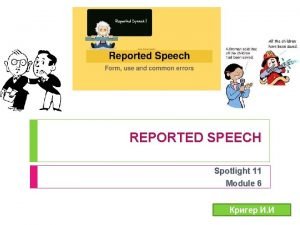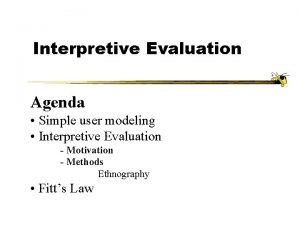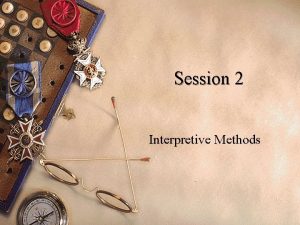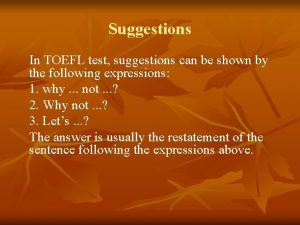Writing Interpretive Reports meaningful useful suggestions Overview l

























- Slides: 25

Writing Interpretive Reports meaningful & useful suggestions

Overview l Personal Growth l Career Counseling l For Other Professionals l Diagnostic Purposes l General Principles

Personal Growth l Create a comprehensive picture of the individual l Relate the test scores to all relevant background information l Lead to practical suggestions, skill development, and compensatory strategies

Career Counseling l Focus on occupational aptitudes and interest l Relate the test scores to the client’s educational and occupational history l Lead the client toward further investigation, goal setting, and decision making

For Other Professionals l Focus on the decision to be made by the other professional l Provide an objective summary of the test results l Relate the test scores to the client’s disposition during testing to establish validity l Limit interpretations and synthesis, report the scores in a more clinical, technical style

Diagnostic Purposes l Typically made by a psychologist, psychiatrist, or multidisciplinary team l Relate the test scores to the client’s disposition during testing to establish validity l Limit interpretations and synthesis to the role of the counselor on the team

General Principles l Ultimately the report format, style, reach, and tone will be determined by: l Who has to make decisions based on the results? l How high are the stakes?

General Principles l Remember that many things influence test scores: l Measurement properties of the test l Cultural factors and client background l The client’s motivation l The client’s experience with other tests l Physical and psychological conditions of the testing l Inherent ability

General Principles l It is always important to comment on and try to establish the degree of validity of the testing situation l However, this section can be very brief if: l The client expressed appropriate behaviors l Took the task seriously l Had no significant distractions or adverse reactions and needed no breaks

General Principles l A valid testing situation is a necessary but not a sufficient condition for strong conclusions l Confine statements to tentative or suggestive language l Do not try to prove or establish fact l Help the client learn and make decisions

SEM and Confidence Intervals l For technically savvy audiences, use the standard error of measurement and confidence interval concepts l For a 95% Confidence Interval l Score + / - (1. 96 * SEM)

SEM and Confidence Intervals l John scored a 97 on an IQ test. l Mean = 100 l SD = 15 l SEM = 3 l What is John’s true IQ?

SEM and Confidence Intervals l We don’t know. l We are 95% confident that John’s true score on this IQ test is between 91 and 103. l If John took this test 100 times, 95 of the intervals we could put around his score would capture his true score.

General Principles l Do not over interpret percentiles l Remember that small changes in T scores near the middle of the distribution can account for relatively large changes in percentiles

General Principles

General Principles l Flat profiles are reasonably likely to occur l It does not necessarily mean something was wrong with the test or examinee motivation l Everything is within the normal range and other indicators are necessary to determine relative strengths and areas for growth

General Principles l Always include a brief description of the purpose for which each test was developed l Briefly describe what each test is intended to measure l Summarize the technical properties of each test

General Principles l Decide on the central message of the report l State it early, and state it again in the summary l Support that message throughout the report with various types of evidence: – Test scores, client background and life experiences, behavioral observations, and client self-disclosures

General Principles l Use carefully chosen adverbs and adjectives to describe behaviors the client might exhibit l Strike a balance between the test scores and other sources of information l Organize and synthesize the information for the reader

General Principles l The test scores themselves may provoke negative reactions for some audiences l Parents may resent or be confused by their child being reduced to “a set of numbers” or “labels” l A simple interpretive summary may be fine

General Principles l It is sometimes helpful to relate the test scores to the client’s: – Past experiences, successes, and failures – Present functioning and life circumstances – Future plans, goals, and life circumstances l Keep a balanced and objective tone l Emphasize both strengths and areas for growth

General Principles l Be aware of how the test scores and the report will be used (or misused) l Be aware of hidden agendas l Sometimes test scores can only hurt someone l Consequential validity of the report

Don’t Ignore Personal Qualities l Personal qualities can be powerful stress buffers and offer compensatory skills – Social connections – Employment history – Life experiences – Common sense – Maturity

Balancing Different Indicators l Playing NCAA Athletics as a freshman

Report Writing Resources l http: //www. msresource. com/format. html l http: //www. msresource. com/theory. html
 What is data converted into a meaningful and useful context
What is data converted into a meaningful and useful context Difference between formal and informal reports
Difference between formal and informal reports Purpose of writing reports
Purpose of writing reports Writing and completing reports and proposals
Writing and completing reports and proposals Prefatory elements in proposal exclude
Prefatory elements in proposal exclude Penulisan laporan singkat
Penulisan laporan singkat Email polite
Email polite Unit 1 letter writing an overview
Unit 1 letter writing an overview Making suggestions with modals + verbs
Making suggestions with modals + verbs Making suggestions expressions
Making suggestions expressions Phrases for making suggestions
Phrases for making suggestions Giving advice dialogue example
Giving advice dialogue example Making plans and suggestions
Making plans and suggestions Direct speech imperative sentence
Direct speech imperative sentence I wasn't or i didn't
I wasn't or i didn't Making suggestions and recommendations
Making suggestions and recommendations Collegial approach
Collegial approach Past modals for judgments and suggestions
Past modals for judgments and suggestions Comments and suggestions for teachers observation
Comments and suggestions for teachers observation Inquire reported speech
Inquire reported speech Suggestions and queries
Suggestions and queries Making suggestions
Making suggestions Change to reported speech
Change to reported speech Life skills chapter 2
Life skills chapter 2 Explain shell interpretive cycle in unix
Explain shell interpretive cycle in unix Clim matrix
Clim matrix
